9. Ariel’s Undersea Adventures
Given that 1989’s The Little Mermaid is remembered as the film that ended Disney’s two decade animation dry spell and launched the Disney Renaissance, it’s surprising how long it took Disney Parks to dedicate a full, permanent attraction to Ariel (and, by the way, all of the Renaissance films). Though a Little Mermaid dark ride was envisioned for Disneyland Paris in the ’90s (a virtual “ride-through” of which was famously included on a special edition Little Mermaid DVD), it would take more than twenty years until the film got the dark ride treatment.

Two Disney Parks feature almost-identical Little Mermaid dark rides. Both have received… mixed reception. That’s probably for a few reasons. Both are “book report” rides that merely retell the ninety minute story in three minutes, cutting out significant scenes & songs while oddly re-ordering them along the way. Both also use the Omnimover ride system that sends guests floating, unnoticed, through continuously-looping scenes instead of having “personal moments” with characters or scenes (like you might on a classic Fantasyland dark ride.)
Likewise, both installations underwent waves of closure in their first years with Imagineers sweeping through to majorly adjust lighting, staging, figures, and even wigs. Emblematic of the issue are several very odd, “off-model” Ariel animatronics that arguably resemble Child’s Play more than Little Mermaid. In either case, once you’ve boarded your “clamshell” (a natural, nautical overlay for the high-capacity, continuously-moving Omnimover ride system), the rides are almost exactly the same. In this case, comparing the Here & There is interesting thanks to the two very different contexts the rides are presented in…
A. The Little Mermaid: Ariel’s Undersea Adventure (Disney California Adventure, 2011)
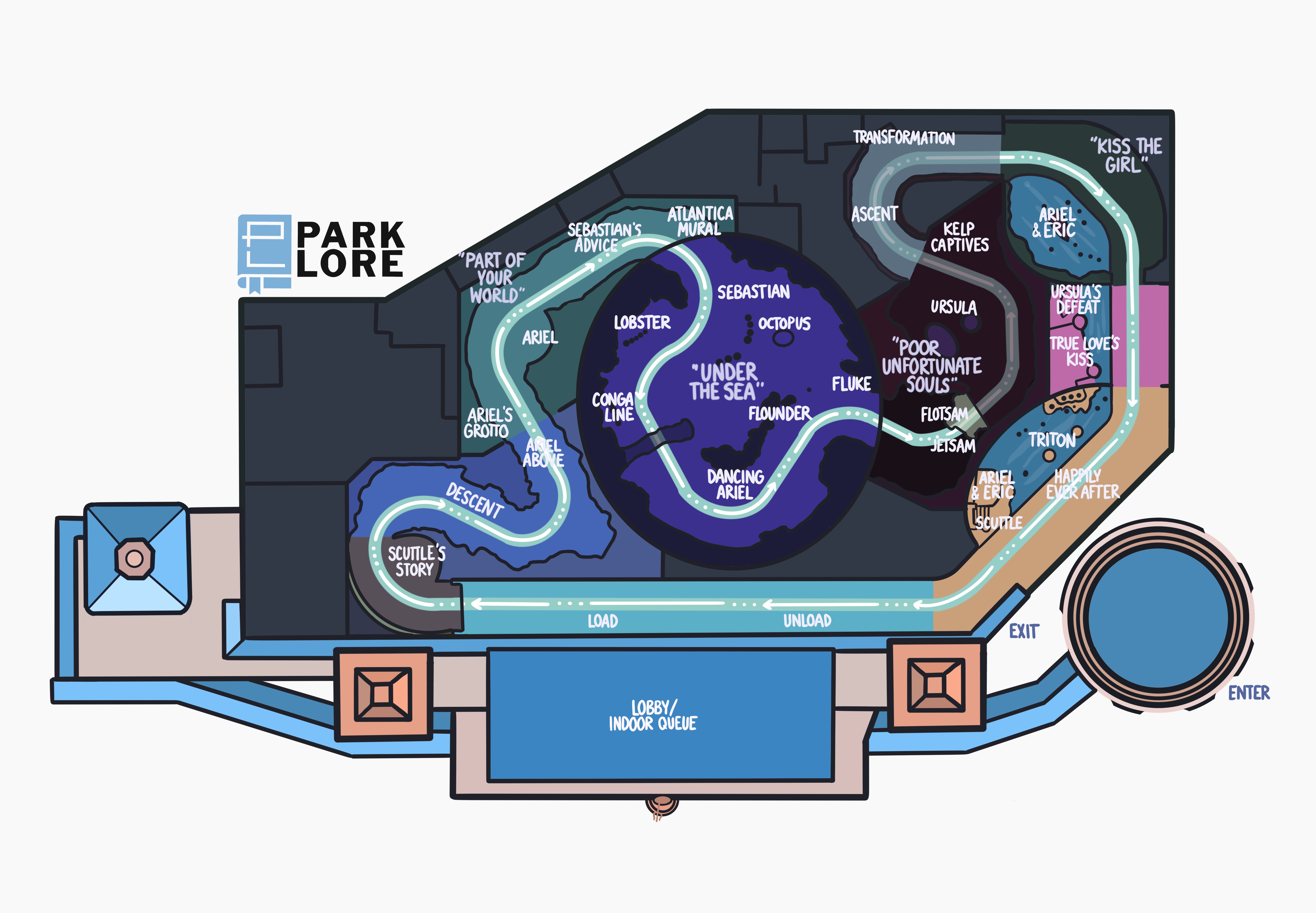
The first Little Mermaid ride opened at Disney California Adventure in 2011. A not-insignificant piece of the park’s five year reimagining, Ariel’s Undersea Adventure added much-needed family capacity, a much-needed dark ride, and much-needed Disney characters to a park that had been criticized as being “too much California, not enough Disney” and having practically nothing for families to do.
In California, the ride replaced “Golden Dreams” – an “edutainment” film starring Whoopi Goldberg that reflected on California’s history and people. All of the “Golden Dreams” theater was demolished except for its entry – a recreation of the iconic dome of San Francisco’s Palace of Fine Arts (originally constructed in 1915 for the Pan-Pacific International Expo) – which was repainted in sandy beige and teal as it was absorbed into the park’s turn-of-the-century Paradise Pier land.
The dark ride itself is contained in a new, from-scratch showbuilding that’s disguised as a sort of palatial, ornate, turn-of-the-century seaside aquarium that fits thematically in Paradise Pier. The building is beautiful, with a grand, arched entry filled with bauble lights, metallic towers with brass seashell finials, and a statue of King Triton overhead. A glass wall leads to a lobby of art nouveau chandeliers resembling glowing, translucent bubbles cradled in seaweed, with guests boarding clamshells in front of an expansive, colorful, Fantasyland-style mural of The Little Mermaid’s tale.
B. Under the Sea: Journey of the Little Mermaid (Magic Kingdom, 2012)
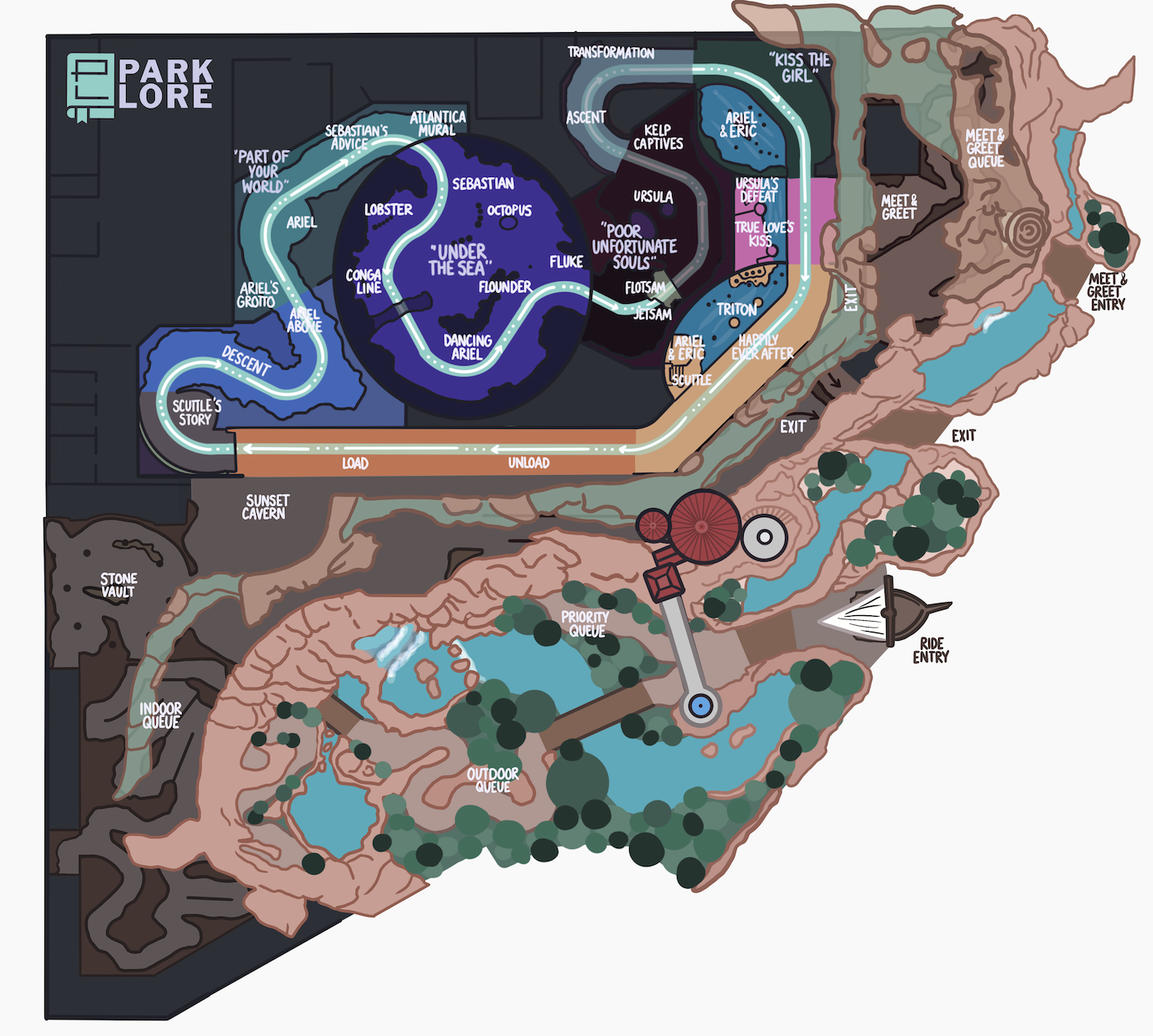
In 2012, Magic Kingdom opened the largest expansion in the park’s history – a “New Fantasyland” (or rather, a new half of Fantasyland) as we saw in our Then & Now comparisons. Clearly one of Disney’s early entries into the then-new “Wizarding World” mindset, New Fantasyland is comprised of immersive, plucked-from-the-screen mini-lands themed to Snow White and the Seven Dwarfs, Dumbo, Beauty and the Beast, and The Little Mermaid, anchored by a clone of California Adventure’s dark ride.
Given its Fantasyland setting, Magic Kingdom’s version of the ride adopted a much more fantastical wrap. Guests enter alongside a shipwreck and wind through pathways wedged between Prince Eric’s seaside castle and waterfall-fed tidal pools. The queue then enters a series of wave-carved “caverns” that include interactive games hosted by Scuttle (in Animatronic form) and some mischievous hermit crabs. Lit by sea glass lanterns and filled with remnants of ships, the caverns eventually lead into vaults “under” the castle, then to the loading area of the ride itself – here with a gorgeous mural of Ariel at sunset, alone on a rock as she gazes across the sea.
All that queue space is needed since Magic Kingdom’s version was built to include FastPass+ (now Lightning Lane), creating a slow-moving Standby line that builds to significant wait times. (High-capacity, continuously loading rides like this are supposed to be the low-wait, high-throughput options you ride with little wait between E-Ticket Lightning Lanes. Case in point: California Adventure’s version of the ride spent most of its life as a pleasant, continuously-available walk-on. However, the Disneyland version got its own Lightning Lane in 2024, predictably causing it to have continuous, lengthy Standby waits, too. Woohoo!)
Other than the queue and the loading area mural, the only noticeable difference between the rides is that Magic Kingdom’s includes an electrical “zapping” sound to accompany the small vignette of Ursula’s death. The ride building itself also re-uses several structural walls from the Lost Legend: 20,000 Leagues Under the Sea, and thus includes backstage support space that Disneyland’s wedged-in showbuilding does not.
10. Mr. Toad’s Wild Rides
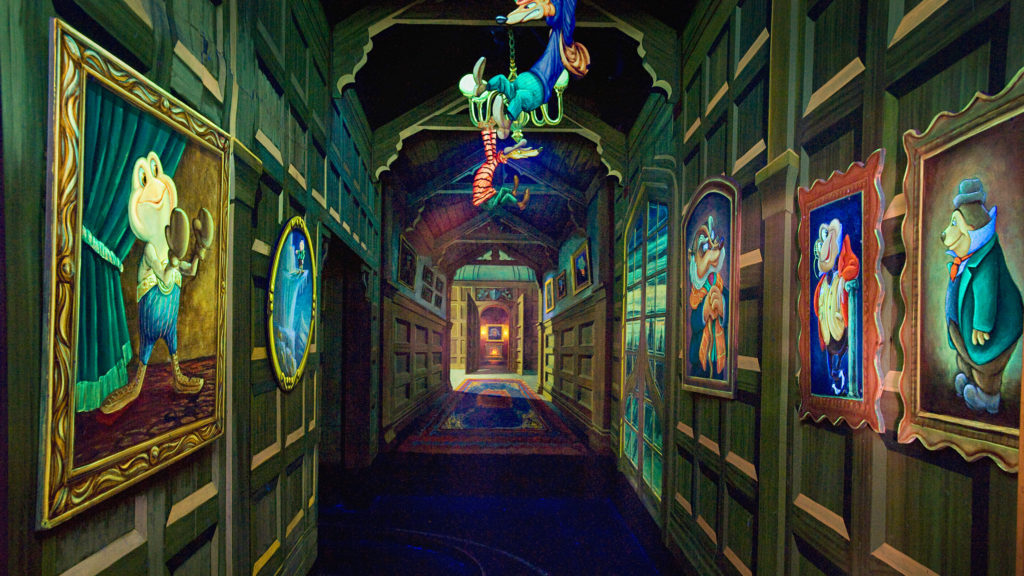
At both Disneyland and Magic Kingdom, Mr. Toad’s Wild Ride was an Opening Day Original. A zippy, zany drive through the English countryside, this Fantasyland classic sends guests merrily on their way to nowhere in particular. It’s about as free-wheeling and fun as any Fantasyland favorite can get. But its two installations took the “Wild Ride” in wildly different directions, literally.
A. Mr. Toad’s Wild Ride (Disneyland, 1955 / 1983)
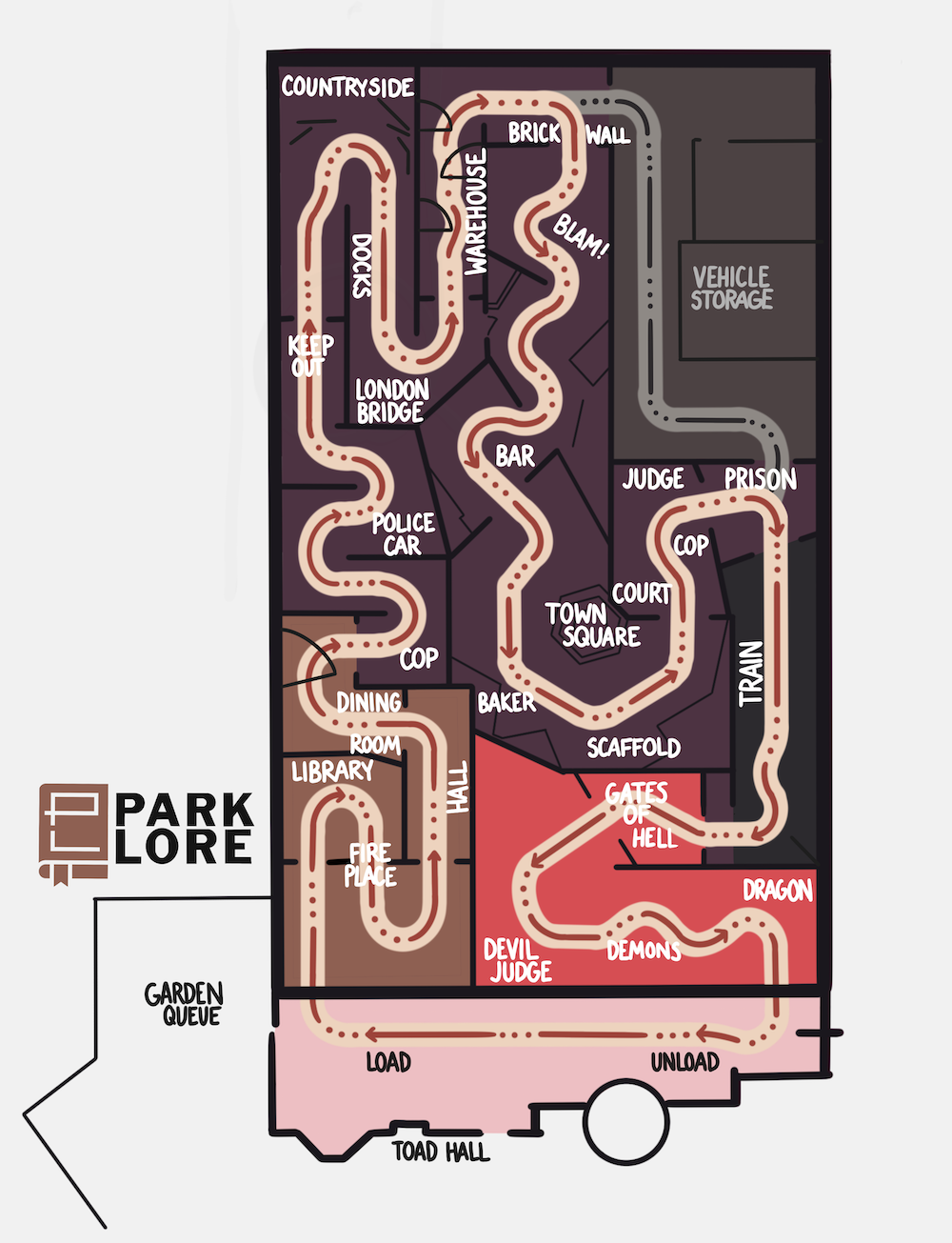
One of three Opening Day Original Fantasyland dark rides at Disneyland. Mr. Toad’s Wild Ride sends guests sputtering through Toad Hall and into the mayhem of the English countryside on horseless carriages. Memorably, the zippy, zany attraction sees guests overcome with “Motor Mania” as they crash through a bar, are sentenced to jail, and – en route to the clink – get struck by a train only to wake up in Hell.
The ride lives up to its name as a wild, wacky counterpart to the serene beauty of Peter Pan’s Flight and the spooky darkness of Snow White. So even if the 1949 package film The Adventures of Ichabod and Mr. Toad is far from the most revered Disney film, Mr. Toad’s Wild Ride still made sense as a ride worth recreating at the new Magic Kingdom…
B. Mr. Toad’s Wild Ride (Magic Kingdom, 1971 – 1998)

It’s telling that when the time came to recreate Fantasyland classics in Florida, it was Mr. Toad’s Wild Ride that was selected not just for duplication, but for expansion! In fact, Orlando’s version – as we chronicled in its own Lost Legends: Mr. Toad’s Wild Ride feature – was two rides in one, with a left and right track that each operated independently.
The clever doubling of the ride added extra kinetics to shared scenes – for example, with multiple cars buzzing through the Town Square, and cars racing toward each other on a shared “One Way Street” (in which both tracks saw themselves as the ones going the wrong way). One track headed through Toad Hall’s Kitchen, out into a Fortune Teller Camp, and through a pub while the other explored the Library, Barnyard, and a Jailbreak. Both, of course, inevitably ended up with riders in Hell.
Speaking of which…
11. The Many Adventures of Winnie the Pooh
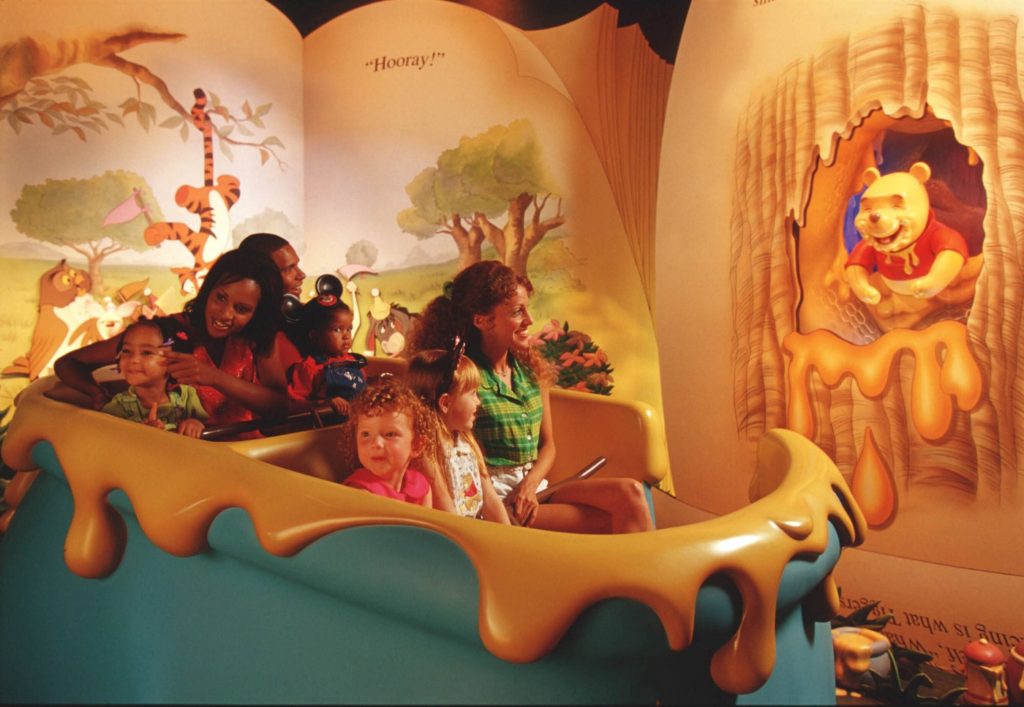
You won’t find too many Disney Parks enthusiasts with a soft spot for the Winnie the Pooh dark rides in the U.S. To start with, neither stateside Pooh ride is great. Whereas the classic “Fantasyland trio” each have a defining characteristic (Snow White’s scariness, Mr. Toad’s absurdity, and Peter Pan’s beauty), The Many Adventures of Winnie the Pooh rides are fairly sedate, bumbling journeys through the Hundred Acre Wood.
The real knock against Pooh, though, is that at both Disneyland and Walt Disney World, the Many Adventures of Winnie the Pooh was allegedly born of an executive edict requiring the parks to install attractions for the character at the height of a resurgence in popularity… even though it meant bulldozing an existing classic to make it happen. Shoehorning Pooh into two different spaces yielded two very different rides.
A. Many Adventures of Winnie the Pooh (Magic Kingdom, 1999)
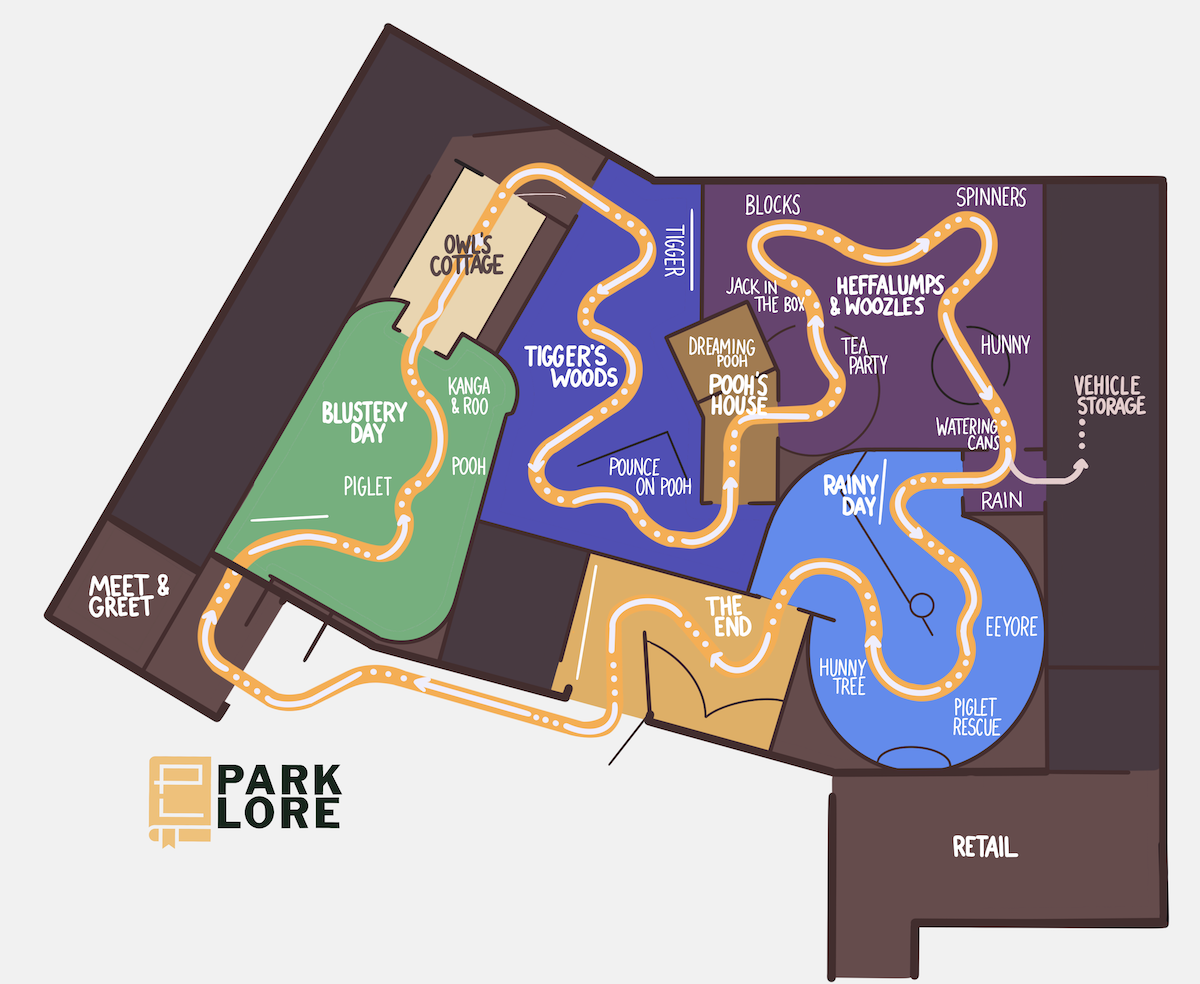
If the shape of this showbuilding looks familiar, that’s for good reason. At Magic Kingdom, The Many Adventures of Winnie the Pooh replaced the Lost Legend: Mr. Toad’s Wild Ride. The former occupant’s double-sized dark ride with two separate tracks meant that the Pooh replacement could fit a dark ride, retail space, and meet-and-greet in one, creating a whole Pooh complex. (Visit our Then & Now feature to see the two rides’ layouts overlaid with a slider to compare.)
Walt Disney World’s Pooh ride isn’t exactly a masterpiece of Imagineering, but it feels like one compared to the ride Disneyland got…
B. Many Adventures of Winnie the Pooh (Disneyland, 2003)

Given that the point of adding a Pooh ride was to have a gift shop to accompany it, it didn’t make sense to close one of Disneyland’s highly-protected (and highly space-limited) Fantasyland dark rides for Pooh. Instead, the dark ride was added to the park’s Critter Country where retail space abounds… and where the Lost Legend: The Country Bear Jamboree was deemed replaceable. (See how the Country Bear Playhouse became the Hundred Acre Wood in our THEN & NOW series.)
Because the Country Bears had been so popular when Magic Kingdom opened, the attraction was copied back to Disneyland with not one, but two theaters offering double capacity. But Disneyland’s more local, repeat audience means that shows tend to have diminishing returns and sparse attendance, so after about 30 years of continuous musical revues, the bears were booted for Pooh.
Frankly, it’s probably okay that the Country Bears’ run came to an end (though we do dream of it returning by way of Disney California Adventure’s Grizzly Peak.) But to fit a dark ride into the rather small theater space, Disneyland ended up with a pretty unimpressive ride… but hey, at least it came with a gift shop and candy shop at the exit!
12. Jurassic River Adventures
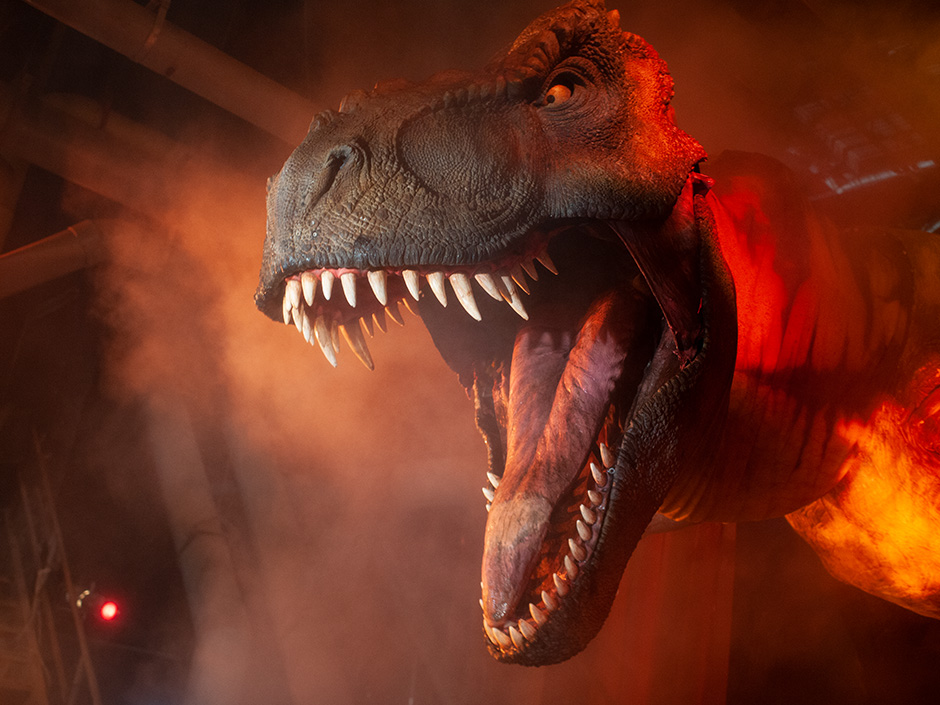
Both Universal Studios Hollywood and Universal Orlando feature scenic river rides through herbivore habitats that go very, very wrong. Even when both were themed to Jurassic Park, they offered slightly different scenes and set-ups. But today, the two have diverged pretty significantly in Universal’s quest to keep their parks caught up with blockbusters.
A. Jurassic World: The Ride (Universal Studios Hollywood, 2019)
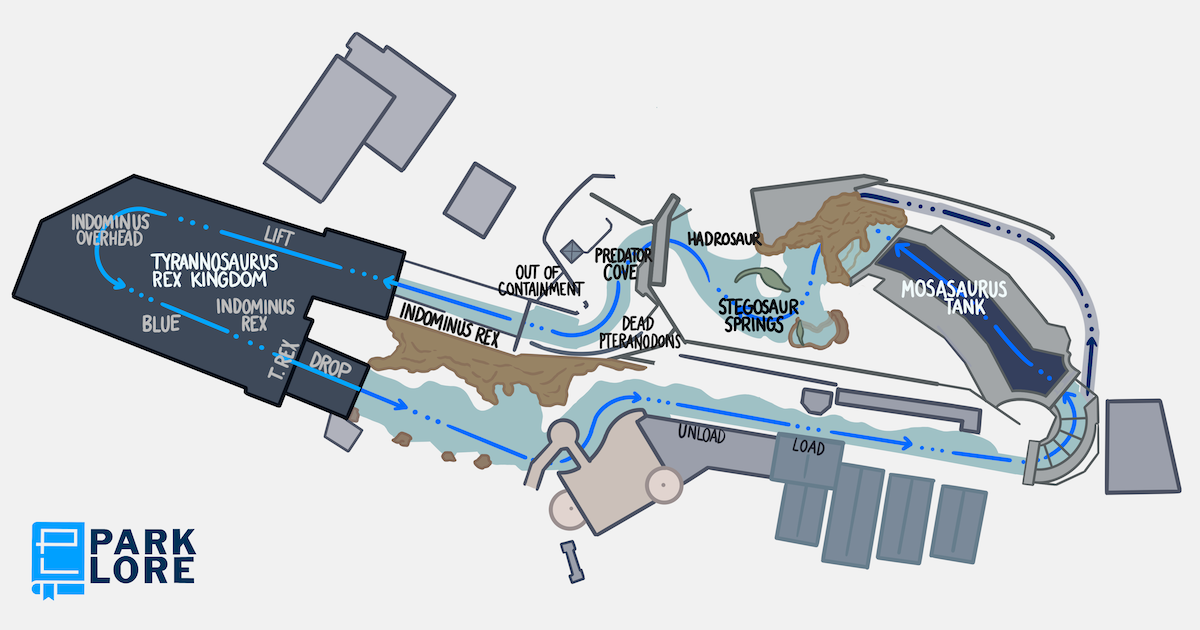
Universal Studios Hollywood actually opened the Lost Legend – Jurassic Park: The Ride back in 1996. What began as a peaceful tour of zoological habitats turned ugly when a playful Hadrosaur innocently knocked riders’ boats off course, diverting them into the Environmental Systems Building and a close encounter with a loose T. rex.
In 2019, the ride re-opened from a facelift as Jurassic World: The Ride, with swapped and refreshed scenes now centered on the more modern film trilogy and its mutant Indominus rex. The resulting ride uses the same ride layout, but as swapped out some key scenes. For example, the Ultrasaur Lagoon was enclosed as a screen-based Mosasaurus tank, the Falling Jeep effect made way for Predator Cove, and the ride’s finale was entirely restaged.
Rather than an “Environmental Systems Building” we were never meant to enter, the towering structure has become the “T. Rex Kingdom” exhibit where one of the most jaw-dropping Audio-Animatronics ever imagined, the Indominus rex herself, is looking for a fight…
B. Jurassic Park River Adventure (Universal’s Islands of Adventure, 1999)
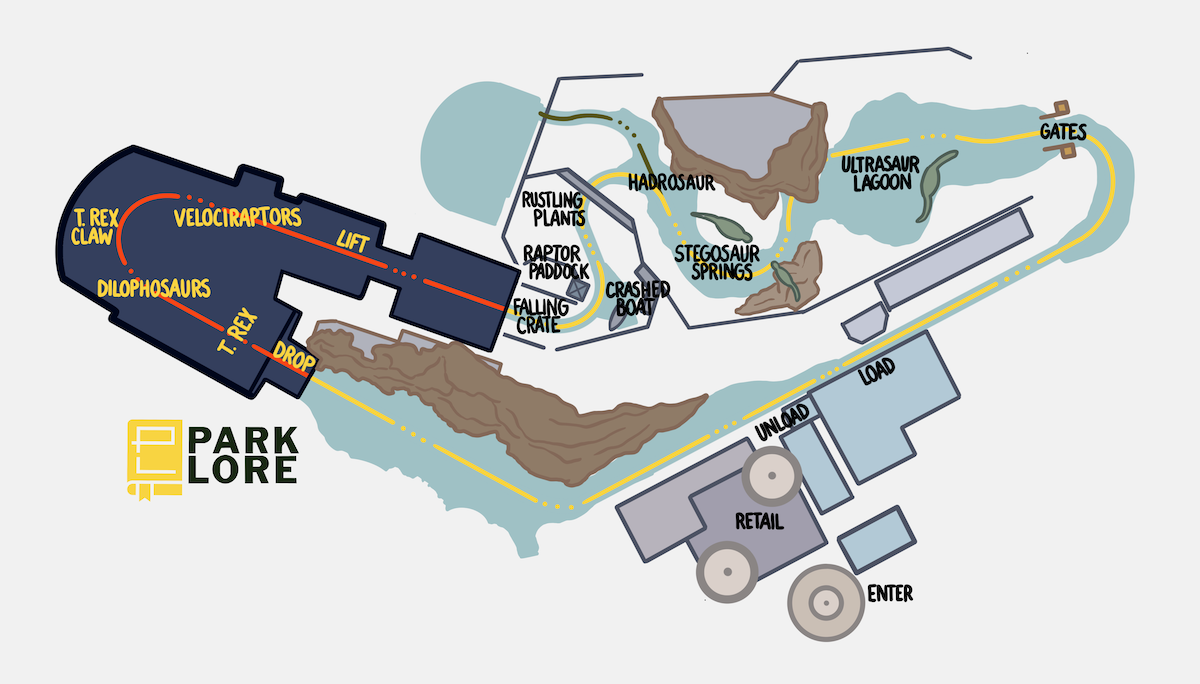
Orlando’s Jurassic Park River Adventure was never an exact clone of Hollywood’s ride to begin with. In Florida, the flume had a more roomy, winding layout (owing to Orlando’s less cramped real estate), the lift and drop were higher, some scenes were swapped, and there were fewer Audio-Animatronics and more weatherproofed covered areas. But now that Hollywood’s version of the ride has gotten the Jurassic World makeover, the two have very few identically analogous scenes remaining.
That doesn’t mean Islands of Adventure’s ride won’t ever get the same facelift. Even though the park has historically been more about stories than movies, the addition of the Jurassic World VelociCoaster shows that the new trilogy has indeed found a home in Florida. But will it overtake the River Adventure and the rest of the Jurassic Park land?
13. Jungle Cruises
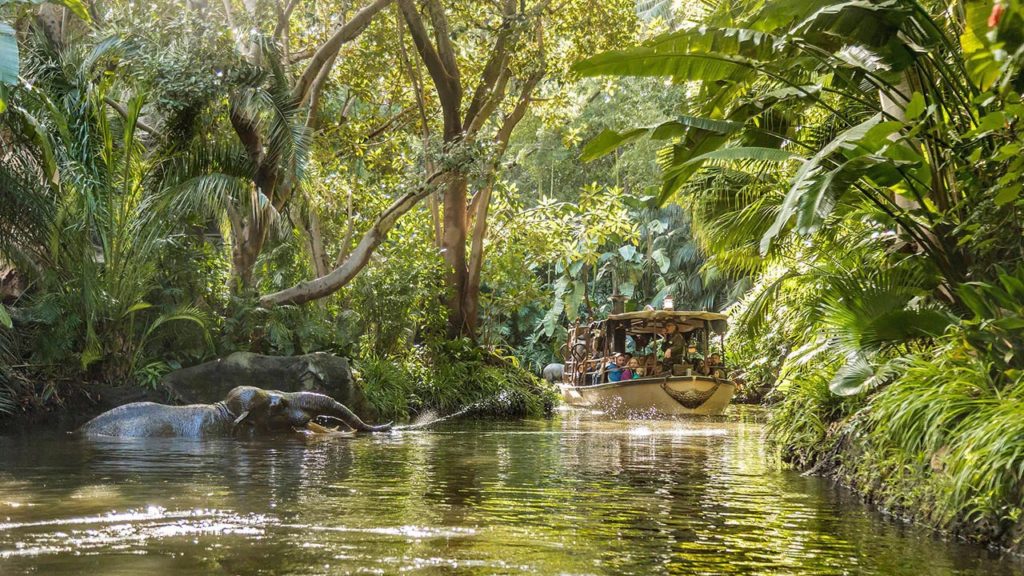
Jungle Cruise is a rare, remaining Opening Day Original for both Disneyland and Magic Kingdom. In general, they’ve grown up together. Usually, changes to one are exported to the other, up to and including the rides’ 2020 reimagining meant to remove some of the more cringe-worthy depictions of the indigenous people of Africa and South America. While they do have a lot in common, the two rides aren’t anywhere near being twins.
A. Jungle Cruise (Disneyland, 1955)

Disneyland’s Jungle Cruise is as classic as they come. A testament to designers’ use of space in the park, the ride’s eastern edge is barely ten feet from the back of Main Street, U.S.A. – but 99% of visitors probably never realize it. In its early days when the ride was a rather serious, documentary-style journey, but the addition of signature scenes by Disney Legend Marc Davis added the animator’s signature humor, stylization, and wordless comedic setups to the ride (the Elephant Bathing Pool, the Trapped Safari, etc.) creating the masterpiece we know today.
In 1994, Jungle Cruise (and much of Adventureland) was “absorbed” into the mythology and timeline of the Modern Marvel – Indiana Jones Adventure: Temple of the Forbidden Eye. The once squeaky-clean boats with their candy-cane-striped awnings were aged and rusted with tattered canvas, plucky 1930s Skippers, and a new multi-story boathouse queue with phonographs sputtering out jazzy jungle standards. Being wrapped up in the larger mythologies of Indiana Jones, the Jungle Navigation Co. Ltd., and S.E.A. arguably makes the Jungle Cruise stronger, even if Disney sometimes over-explains itself.
B. Jungle Cruise (Magic Kingdom, 1971)
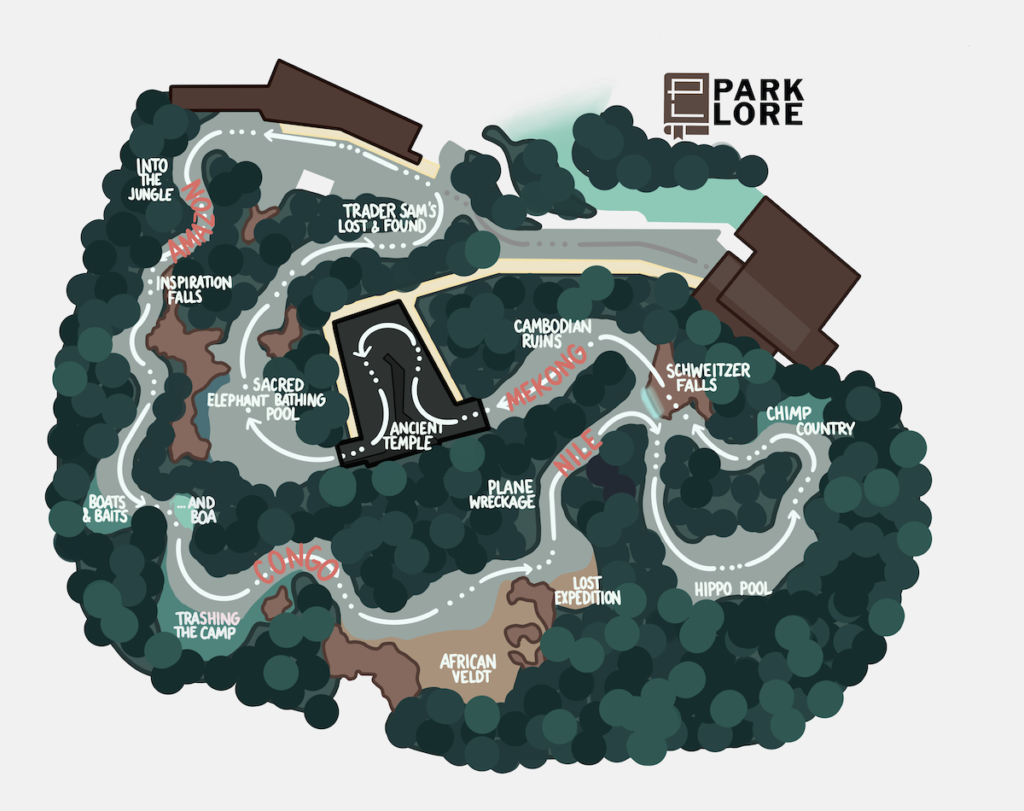
Magic Kingdom’s Jungle Cruise opened with Marc Davis’ scenes already installed, and with the “blessing of size” that Disneyland doesn’t have. The result is that Florida’s version of the ride takes up more room, has its scenes re-ordered, and has at least one scene California’s doesn’t share: the indoor Cambodian Temple.
In 1994, Magic Kingdom’s ride was “aged” in the same manner as Disneyland’s, even though Magic Kingdom doesn’t have an Indiana Jones Adventure. The pre-war “vibe” is still effective, and lends itself to the nearby Jungle Navigation Co. Ltd. Skipper Canteen restaurant, which threads the Jungle Cruise’s narrative into a larger mythology.


